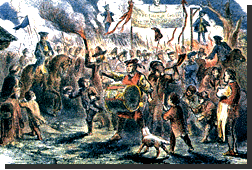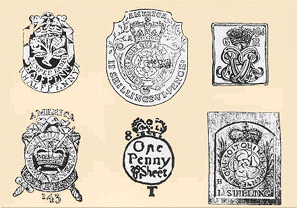![]()

A
tax stamp manufactured for the Stamp Act
![]()
![]()
![]()
![]()
The Stamp Act, sponsored by George Grenville, was the first direct tax imposed by Britain on its American colonies. To help cover the cost of maintaining troops in the colonies, Parliament levied a tax on legal and commercial documents as well as printed material such as newspapers and pamphlets, all of which had to carry a special stamp. Benjamin Franklin and other American agents in London offered alternative measures, but conceded the need for revenue from America.
The act took effect in November 1765. Americans, who did not elect members ofParliament, opposed the act not only because of their inability to pay the tax, but also because it violated the newly enunciated principle of "No taxation without representation." This measure aroused the grievances of the colonists, and their concerted action in response paved the way for the American Revolution.

Protest
against the Stamp Act
The sign in the background reads:
"The Folly of England and the Ruin of America"
Resistance to
the statute took the form of petitions to the king and Parliament, a boycott
of British goods, the refusal of lawyers
or printers
to use stamps or stamped paper, and violence sparked by the Sons Of Liberty.
In New York, rioters demolished the house of a British officer who said
he "would cram the stamps down American throats at the point of his sword."
The Massachusetts legislature spearheaded the formation of the first general intercolonial conference, the Stamp Act Congress, consisting of delegates from 9 of the 13 colonies (Massachusetts, Connecticut, Rhode Island, New York, New Jersey, Pennsylvania, Delaware, Maryland, and South Carolina), that met in New York from October 7 to 25 and framed an address to King George III, petitions to Parliament, and a declaration of rights and grievances.

Parliament rescinded the statute on Mar. 18, 1766, but it coupled repeal with passage of the Declaratory Act, which asserted Britain's supremacy over America "in all cases whatsoever." The constitutional principles and protest tactics established during the Stamp Act crisis laid the groundwork for the American Revolution.
~ The Reaction ~
Strongly protested and resisted, the Stamp Act was recognized as unenforceable and was repealed on March 18, 1766. Simultaneously, however, Parliament passed the Declaratory Act, affirming its continuing authority over colonial legislatures.
![]()